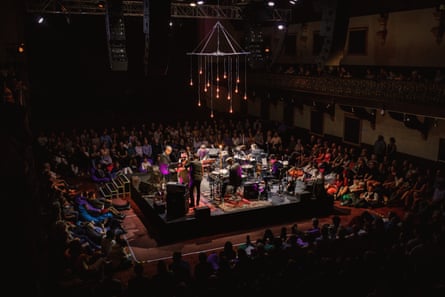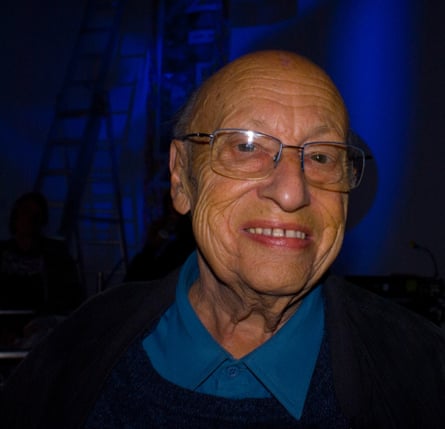In 1941, a curious electronic instrument was invented that combined the possibility for depth of a horn section and the silliness of a children’s novelty toy. The key was how it was played and cared for – and what you composed for it.
The ondioline was invented by the French poet and musician Georges Jenny. Broadly speaking it’s a synthesiser built on a circuit board that looks like a child’s keyboard. It produces a sort of a blurry, vibrating sound, like music playing in another room.
In 1951, a French medical student named Jean-Jacques Perrey heard the instrument and became its No 1 fan. He left his medical studies and travelled to America, where he lived for 10 years, promoting and playing the ondioline. But the need to care for ageing parents brought the pioneer of electronic music back to France and the ondioline sunk into obscurity once again.
The Australian musician Wally de Backer is working to bring it back.
Known by his stage name Gotye – and for his 2011 hit with Kimbra, Somebody That I Used To Know – de Backer, like Perrey before him, is carrying the torch for the ondionine, paying tribute to it in a series of performances around Australia this month. The shows are the culmination of a decade-long obsession with the instrument, which he first heard in 2005 in a Richmond studio where he was recording his second album, Like Drawing Blood.
He was immediately struck by its sound. “I loved it – it has such an effervescence to it,” he says. “On the surface it has a simplicity, it may be very charming and very childlike, but there’s also a real musical muscularity.”

There have been about 700 ondiolines made but, by the time de Backer started searching for an instrument of his own, the people who owned one could be listed on three hands. Their locations in France and the US were pinned on a map he found in an internet chatroom; de Backer would leave his contact details at nearby shops, urging people to contact him should an ondioline be found.
When de Backer tells all this to Guardian Australia in the foyer of a Launceston hotel, he puts on a very credible French accent to channel the shopkeepers: “Ahh, zee ondioline – they are very hard to find.”
Finally he tracked one down, in Connecticut. With a rusted bottom, it was unplayable and needed thousands of dollars worth of specialist restoration. But the search had taken the artist close to five years; he wasn’t going to give up.
The evening before we meet, on the first night of Mona Foma festival in Launceston, de Backer invited the crowd to sit on the floor behind him, to get a better look at the insides of this instrument, which he has miraculously brought back to life. The rest of us sat looking down at the stage as the sound floated up from his instrument and the accompanying “ondioline orchestra”. It was spellbinding.
The ondioline had not travelled well. It had been stored a freezing warehouse in Queens before being air freighted to the Australian summer and the sudden changes in temperature had affected its sound. The concert was delayed while emergency repairs were undertaken; de Backer employs someone pretty much full-time to fix his collection of ondiolines, which now numbers 11.

“I think I am touring it because I need to push through the feeling of walking on eggshells,” he says. “I just want to share this thing as widely as possible.”
De Backer and the ondioline is a love story between musician and instrument; he talked non-stop for almost an hour about it, and could have probably kept going.
In the 1990s, he tells me, the instrument enjoyed a brief renaissance when it was sampled by the Beastie Boys and Beck. “Things that people saw as kitschy and cheesecake – there was a big craze for exotica revival thrift shop bin digging, and Jean-Jacques was swept up in that.”
But the craze, de Backer says, did a disservice to the instrument’s potential for depth: “There is stuff that really stands above the fray, arranged with sounds unlike anyone else’s sounds. It’s more than cheesecake.”
Between 2013 and 2016, he did a deep dive into the ondioline world: one sparsely populated by collectors, restorers; those who had tried and failed to get their machines to sound like they did on old records. But, he says: “They all have the same story. After spending thousands on restoring it, they can’t get it to work and the ondioline becomes this trophy in the corner – a relic of long gone possibility.”
The journey to acquire and learn more about the instrument led de Backer into the Swiss home of the ondioline’s greatest proponent: Jean-Jacques Perrey.

In 2013 De Backer wrote to Perrey, in his 80s at this stage and suffering bouts of ill health with dementia and rheumatoid arthritis. His daughter wrote back, inviting the Australian musician to “drop in” if he ever found himself in Switzerland.
“I didn’t have anything on in Switzerland but I went anyway,” says de Backer, in the time honoured tradition of an ardent suitor. The meeting was a great success. “He was such a warm-spirited, lovely human being,” he says.
“The main feeling I came away with was that I had met a kindred spirit – I describe it as having met my grandfather, my spiritual grandfather. I went home thinking I wasn’t sure if I would see him again but I really wanted to.”
It turns out Perrey wanted to see de Backer again, too.
One visit turned into several more. Over time, once trust developed, de Backer was invited to curate and organise Perrey’s archive of work, including very fragile acetylene recordings that are not designed to be listened to more than two or three times. (“When you put the needle in the groove, it starts scraping away the music. Your first pass [at digitising] is your best pass, as the music can disappear from the wax.”)
De Backer stayed in a small hotel in Lausanne, close to Perrey’s home. He would walk there in the afternoon, to spend a few hours with his spiritual grandfather before joining him for dinner. He learned French so the two could talk.

“Getting to know him, and listening to some of his unreleased tracks that are up there with his best recordings, I had this little spark ... I thought, ‘There’s an album’s worth of stuff there.”
That album, Jean-Jacques Perrey Et Son Ondioline, was curated by De Backer and released on a label he set up for the purpose last year.
But Perrey never got to hear the finished result; he died in November 2016, just one week before De Backer premiered his tribute show in New York.
De Backer, who is now based full time in New York, says, “I feel a kinship with Perrey because I’m this guy from the suburbs of Melbourne, he was someone from a small country town in France, and now I am in New York connecting with all these amazing electronic music pioneers.”
The spirit of the instrument also chimed with de Backer.
“There are things we can do with our bodies that, when you refine them, to a certain extent, it results in very exquisite, magical outcomes,” he says.
“When I engage with a big electronic instrument, I feel like I’m trying to punch my brain into a cord, into the machine, leading to a signal path. But the ondioline more relates to acoustic, analogue music. You’re trying to engage with this little thing, like a little cabinet. It has these clunky mechanical parts that you try and feel out – but once you find those little details, it can be so expressive.”

Comments (…)
Sign in or create your Guardian account to join the discussion